Employee Relations and its Impact
VerifiedAdded on 2020/02/14
|14
|5569
|283
AI Summary
This assignment delves into the crucial field of Employee Relations. It examines various aspects, including employee engagement, voice, and the role of emotional intelligence in fostering positive workplace dynamics. The analysis draws upon academic research and publications to highlight the impact of effective employee relations on organizational success.
Contribute Materials
Your contribution can guide someone’s learning journey. Share your
documents today.
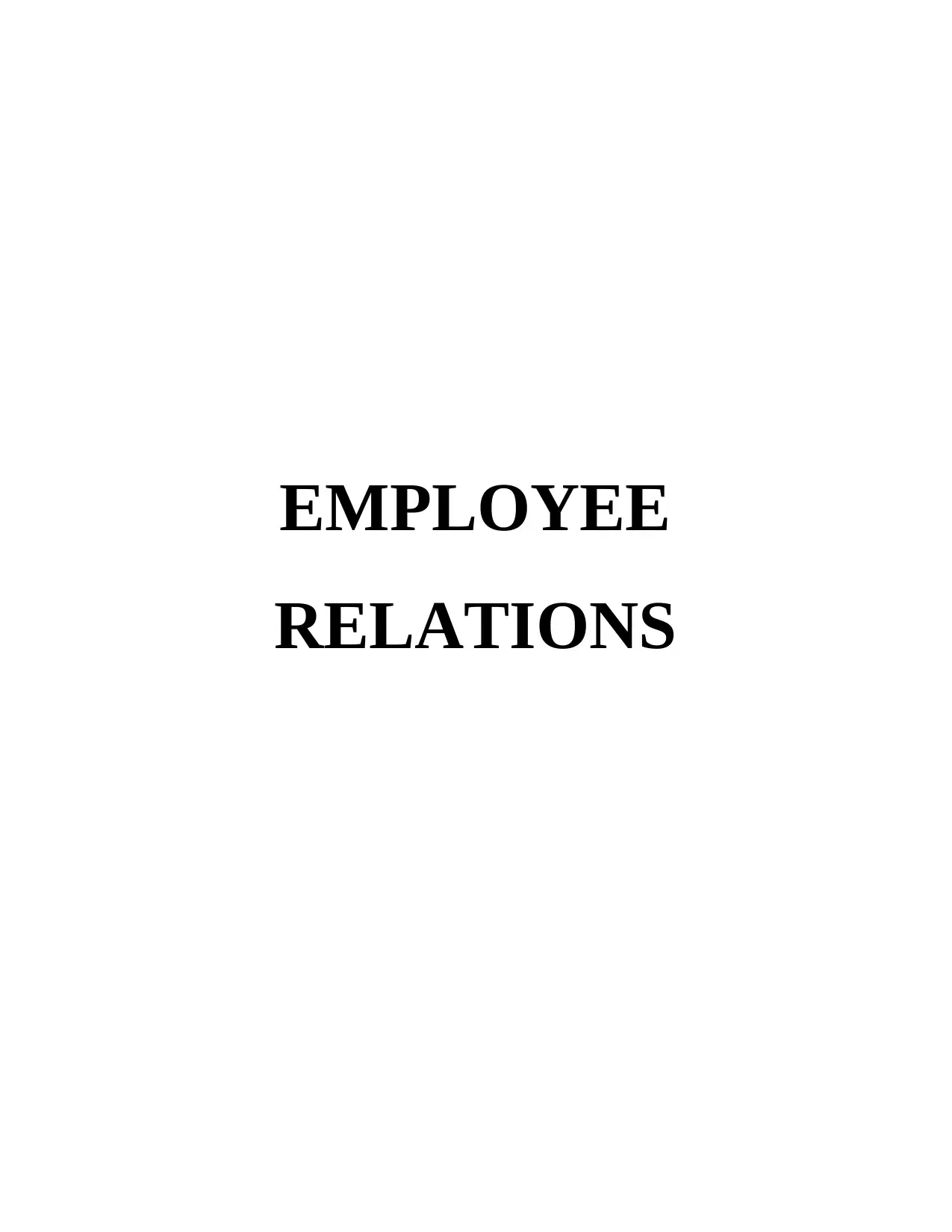
EMPLOYEE
RELATIONS
RELATIONS
Secure Best Marks with AI Grader
Need help grading? Try our AI Grader for instant feedback on your assignments.
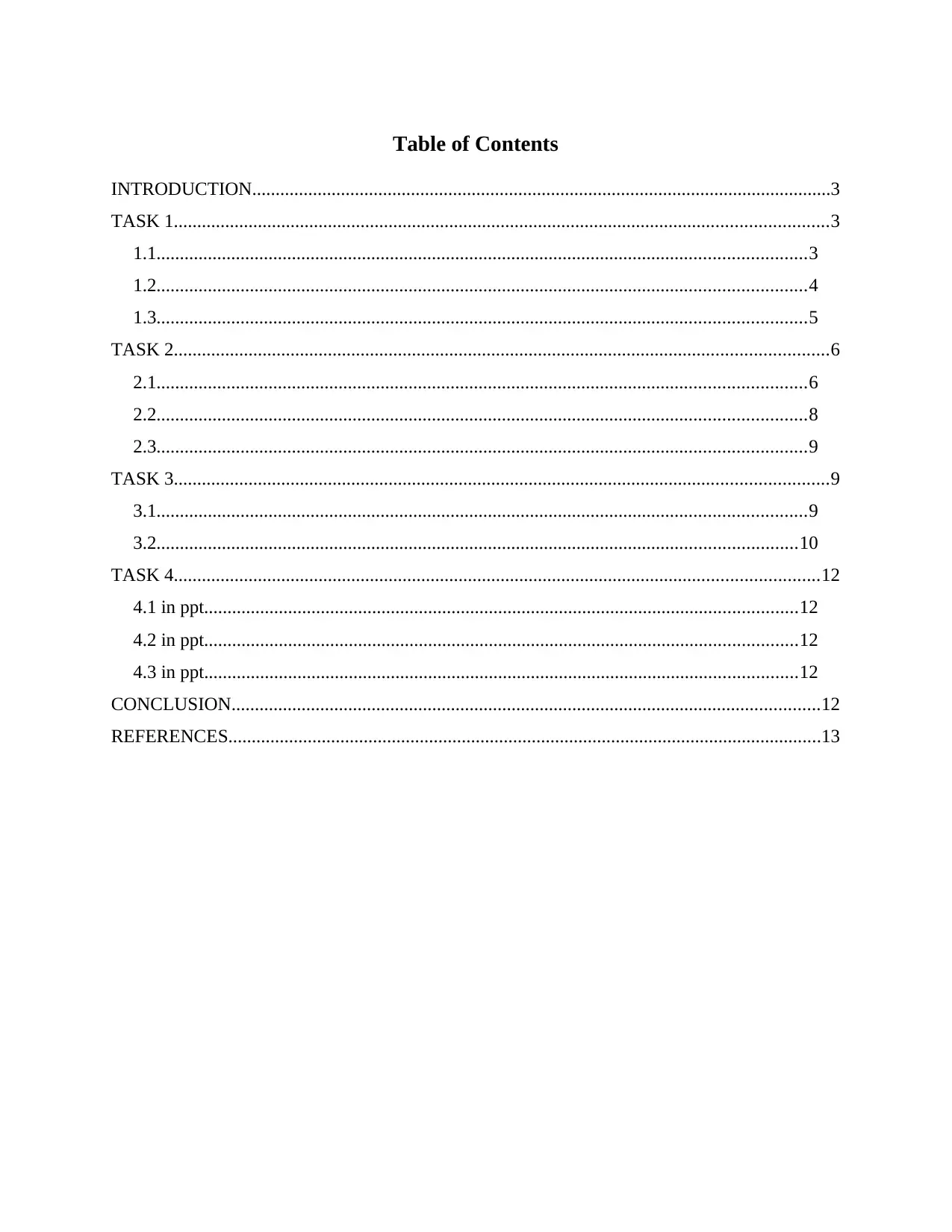
Table of Contents
INTRODUCTION............................................................................................................................3
TASK 1............................................................................................................................................3
1.1...........................................................................................................................................3
1.2...........................................................................................................................................4
1.3...........................................................................................................................................5
TASK 2............................................................................................................................................6
2.1...........................................................................................................................................6
2.2...........................................................................................................................................8
2.3...........................................................................................................................................9
TASK 3............................................................................................................................................9
3.1...........................................................................................................................................9
3.2.........................................................................................................................................10
TASK 4..........................................................................................................................................12
4.1 in ppt...............................................................................................................................12
4.2 in ppt...............................................................................................................................12
4.3 in ppt...............................................................................................................................12
CONCLUSION..............................................................................................................................12
REFERENCES...............................................................................................................................13
INTRODUCTION............................................................................................................................3
TASK 1............................................................................................................................................3
1.1...........................................................................................................................................3
1.2...........................................................................................................................................4
1.3...........................................................................................................................................5
TASK 2............................................................................................................................................6
2.1...........................................................................................................................................6
2.2...........................................................................................................................................8
2.3...........................................................................................................................................9
TASK 3............................................................................................................................................9
3.1...........................................................................................................................................9
3.2.........................................................................................................................................10
TASK 4..........................................................................................................................................12
4.1 in ppt...............................................................................................................................12
4.2 in ppt...............................................................................................................................12
4.3 in ppt...............................................................................................................................12
CONCLUSION..............................................................................................................................12
REFERENCES...............................................................................................................................13
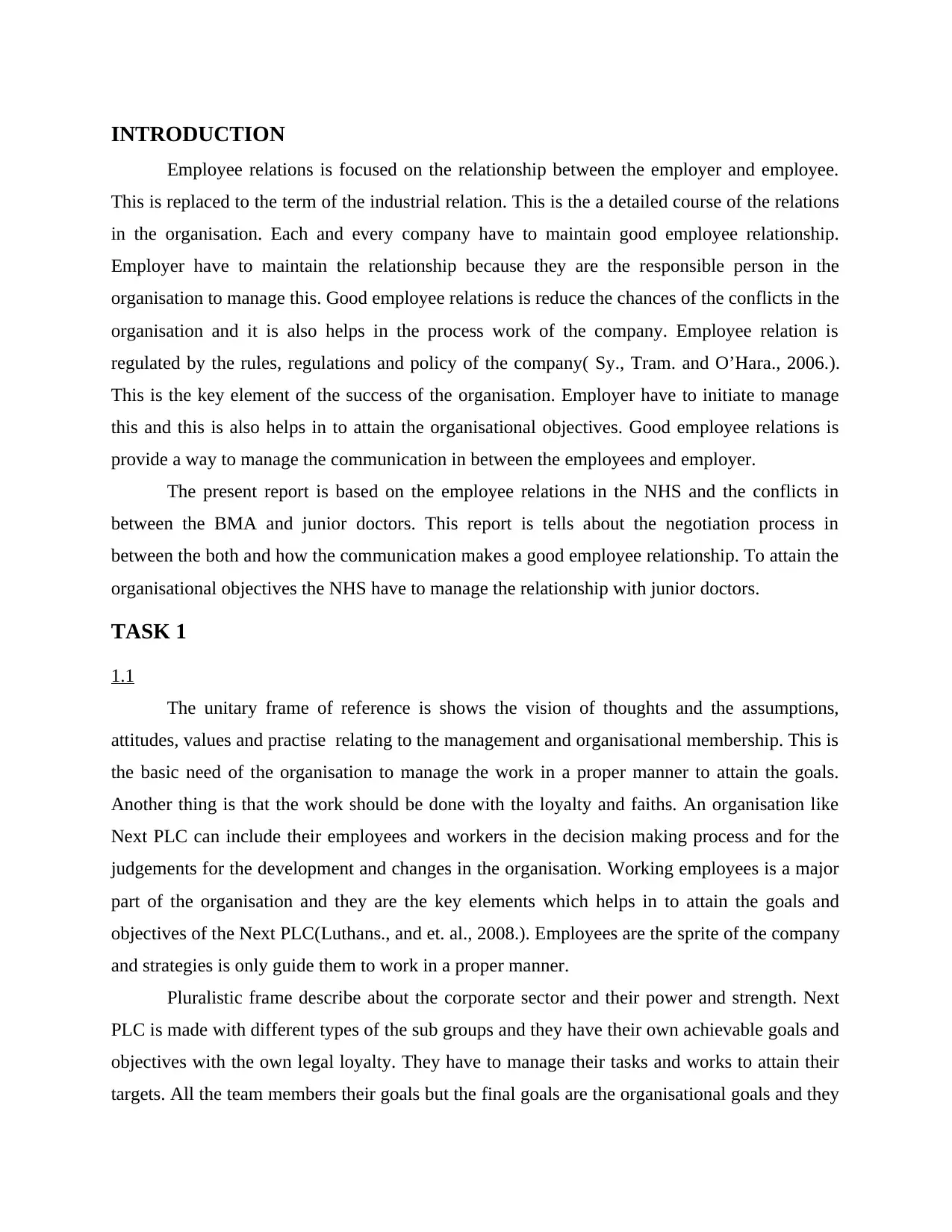
INTRODUCTION
Employee relations is focused on the relationship between the employer and employee.
This is replaced to the term of the industrial relation. This is the a detailed course of the relations
in the organisation. Each and every company have to maintain good employee relationship.
Employer have to maintain the relationship because they are the responsible person in the
organisation to manage this. Good employee relations is reduce the chances of the conflicts in the
organisation and it is also helps in the process work of the company. Employee relation is
regulated by the rules, regulations and policy of the company( Sy., Tram. and O’Hara., 2006.).
This is the key element of the success of the organisation. Employer have to initiate to manage
this and this is also helps in to attain the organisational objectives. Good employee relations is
provide a way to manage the communication in between the employees and employer.
The present report is based on the employee relations in the NHS and the conflicts in
between the BMA and junior doctors. This report is tells about the negotiation process in
between the both and how the communication makes a good employee relationship. To attain the
organisational objectives the NHS have to manage the relationship with junior doctors.
TASK 1
1.1
The unitary frame of reference is shows the vision of thoughts and the assumptions,
attitudes, values and practise relating to the management and organisational membership. This is
the basic need of the organisation to manage the work in a proper manner to attain the goals.
Another thing is that the work should be done with the loyalty and faiths. An organisation like
Next PLC can include their employees and workers in the decision making process and for the
judgements for the development and changes in the organisation. Working employees is a major
part of the organisation and they are the key elements which helps in to attain the goals and
objectives of the Next PLC(Luthans., and et. al., 2008.). Employees are the sprite of the company
and strategies is only guide them to work in a proper manner.
Pluralistic frame describe about the corporate sector and their power and strength. Next
PLC is made with different types of the sub groups and they have their own achievable goals and
objectives with the own legal loyalty. They have to manage their tasks and works to attain their
targets. All the team members their goals but the final goals are the organisational goals and they
Employee relations is focused on the relationship between the employer and employee.
This is replaced to the term of the industrial relation. This is the a detailed course of the relations
in the organisation. Each and every company have to maintain good employee relationship.
Employer have to maintain the relationship because they are the responsible person in the
organisation to manage this. Good employee relations is reduce the chances of the conflicts in the
organisation and it is also helps in the process work of the company. Employee relation is
regulated by the rules, regulations and policy of the company( Sy., Tram. and O’Hara., 2006.).
This is the key element of the success of the organisation. Employer have to initiate to manage
this and this is also helps in to attain the organisational objectives. Good employee relations is
provide a way to manage the communication in between the employees and employer.
The present report is based on the employee relations in the NHS and the conflicts in
between the BMA and junior doctors. This report is tells about the negotiation process in
between the both and how the communication makes a good employee relationship. To attain the
organisational objectives the NHS have to manage the relationship with junior doctors.
TASK 1
1.1
The unitary frame of reference is shows the vision of thoughts and the assumptions,
attitudes, values and practise relating to the management and organisational membership. This is
the basic need of the organisation to manage the work in a proper manner to attain the goals.
Another thing is that the work should be done with the loyalty and faiths. An organisation like
Next PLC can include their employees and workers in the decision making process and for the
judgements for the development and changes in the organisation. Working employees is a major
part of the organisation and they are the key elements which helps in to attain the goals and
objectives of the Next PLC(Luthans., and et. al., 2008.). Employees are the sprite of the company
and strategies is only guide them to work in a proper manner.
Pluralistic frame describe about the corporate sector and their power and strength. Next
PLC is made with different types of the sub groups and they have their own achievable goals and
objectives with the own legal loyalty. They have to manage their tasks and works to attain their
targets. All the team members their goals but the final goals are the organisational goals and they
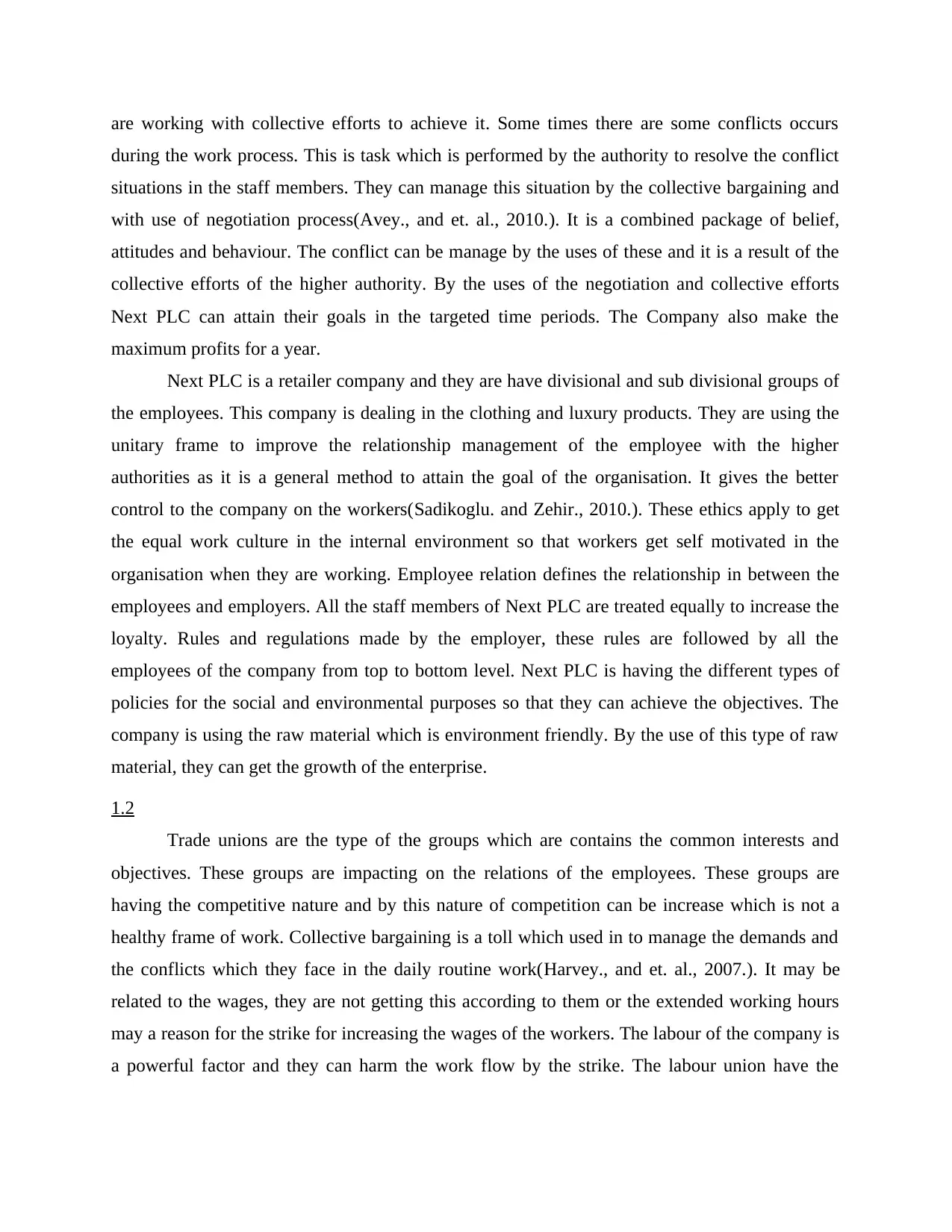
are working with collective efforts to achieve it. Some times there are some conflicts occurs
during the work process. This is task which is performed by the authority to resolve the conflict
situations in the staff members. They can manage this situation by the collective bargaining and
with use of negotiation process(Avey., and et. al., 2010.). It is a combined package of belief,
attitudes and behaviour. The conflict can be manage by the uses of these and it is a result of the
collective efforts of the higher authority. By the uses of the negotiation and collective efforts
Next PLC can attain their goals in the targeted time periods. The Company also make the
maximum profits for a year.
Next PLC is a retailer company and they are have divisional and sub divisional groups of
the employees. This company is dealing in the clothing and luxury products. They are using the
unitary frame to improve the relationship management of the employee with the higher
authorities as it is a general method to attain the goal of the organisation. It gives the better
control to the company on the workers(Sadikoglu. and Zehir., 2010.). These ethics apply to get
the equal work culture in the internal environment so that workers get self motivated in the
organisation when they are working. Employee relation defines the relationship in between the
employees and employers. All the staff members of Next PLC are treated equally to increase the
loyalty. Rules and regulations made by the employer, these rules are followed by all the
employees of the company from top to bottom level. Next PLC is having the different types of
policies for the social and environmental purposes so that they can achieve the objectives. The
company is using the raw material which is environment friendly. By the use of this type of raw
material, they can get the growth of the enterprise.
1.2
Trade unions are the type of the groups which are contains the common interests and
objectives. These groups are impacting on the relations of the employees. These groups are
having the competitive nature and by this nature of competition can be increase which is not a
healthy frame of work. Collective bargaining is a toll which used in to manage the demands and
the conflicts which they face in the daily routine work(Harvey., and et. al., 2007.). It may be
related to the wages, they are not getting this according to them or the extended working hours
may a reason for the strike for increasing the wages of the workers. The labour of the company is
a powerful factor and they can harm the work flow by the strike. The labour union have the
during the work process. This is task which is performed by the authority to resolve the conflict
situations in the staff members. They can manage this situation by the collective bargaining and
with use of negotiation process(Avey., and et. al., 2010.). It is a combined package of belief,
attitudes and behaviour. The conflict can be manage by the uses of these and it is a result of the
collective efforts of the higher authority. By the uses of the negotiation and collective efforts
Next PLC can attain their goals in the targeted time periods. The Company also make the
maximum profits for a year.
Next PLC is a retailer company and they are have divisional and sub divisional groups of
the employees. This company is dealing in the clothing and luxury products. They are using the
unitary frame to improve the relationship management of the employee with the higher
authorities as it is a general method to attain the goal of the organisation. It gives the better
control to the company on the workers(Sadikoglu. and Zehir., 2010.). These ethics apply to get
the equal work culture in the internal environment so that workers get self motivated in the
organisation when they are working. Employee relation defines the relationship in between the
employees and employers. All the staff members of Next PLC are treated equally to increase the
loyalty. Rules and regulations made by the employer, these rules are followed by all the
employees of the company from top to bottom level. Next PLC is having the different types of
policies for the social and environmental purposes so that they can achieve the objectives. The
company is using the raw material which is environment friendly. By the use of this type of raw
material, they can get the growth of the enterprise.
1.2
Trade unions are the type of the groups which are contains the common interests and
objectives. These groups are impacting on the relations of the employees. These groups are
having the competitive nature and by this nature of competition can be increase which is not a
healthy frame of work. Collective bargaining is a toll which used in to manage the demands and
the conflicts which they face in the daily routine work(Harvey., and et. al., 2007.). It may be
related to the wages, they are not getting this according to them or the extended working hours
may a reason for the strike for increasing the wages of the workers. The labour of the company is
a powerful factor and they can harm the work flow by the strike. The labour union have the
Secure Best Marks with AI Grader
Need help grading? Try our AI Grader for instant feedback on your assignments.
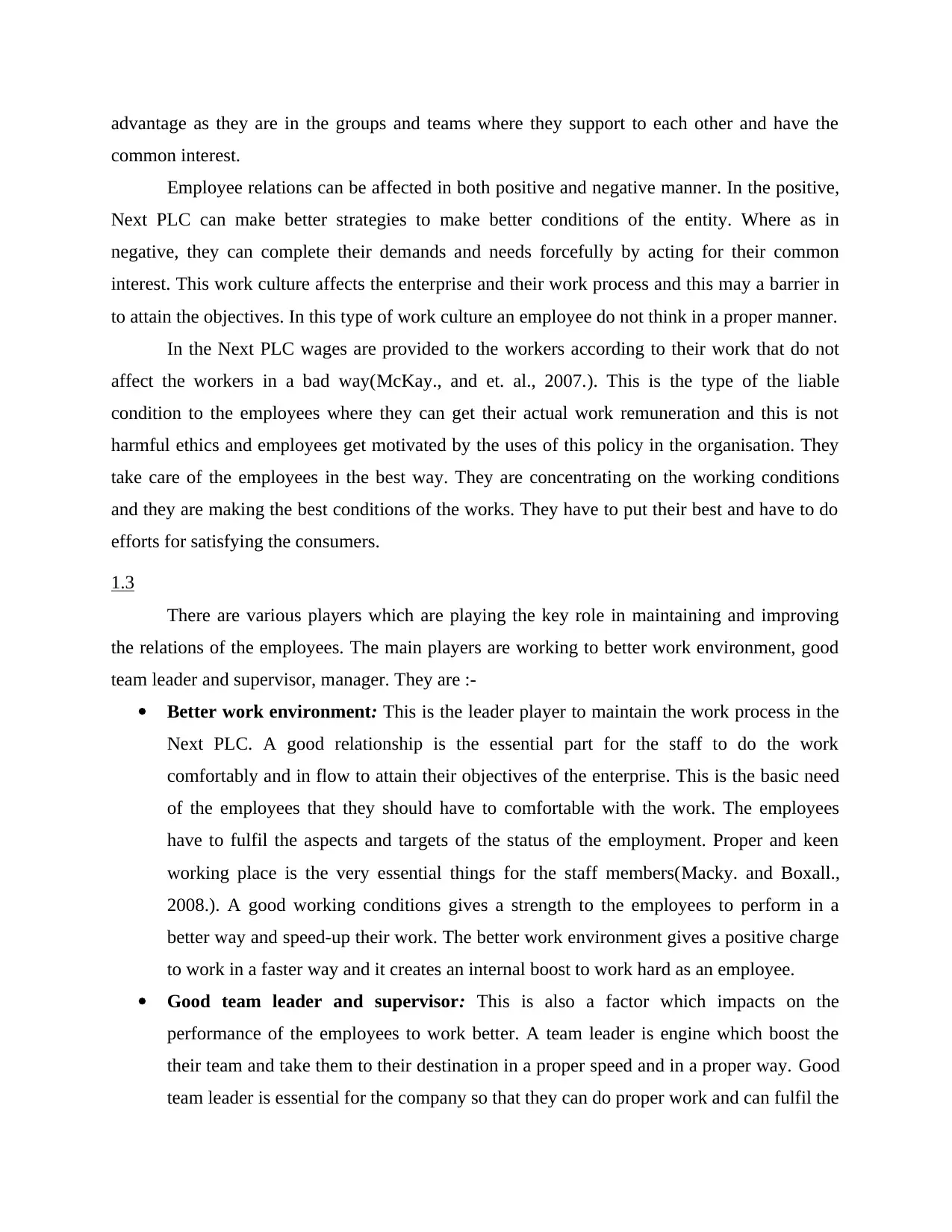
advantage as they are in the groups and teams where they support to each other and have the
common interest.
Employee relations can be affected in both positive and negative manner. In the positive,
Next PLC can make better strategies to make better conditions of the entity. Where as in
negative, they can complete their demands and needs forcefully by acting for their common
interest. This work culture affects the enterprise and their work process and this may a barrier in
to attain the objectives. In this type of work culture an employee do not think in a proper manner.
In the Next PLC wages are provided to the workers according to their work that do not
affect the workers in a bad way(McKay., and et. al., 2007.). This is the type of the liable
condition to the employees where they can get their actual work remuneration and this is not
harmful ethics and employees get motivated by the uses of this policy in the organisation. They
take care of the employees in the best way. They are concentrating on the working conditions
and they are making the best conditions of the works. They have to put their best and have to do
efforts for satisfying the consumers.
1.3
There are various players which are playing the key role in maintaining and improving
the relations of the employees. The main players are working to better work environment, good
team leader and supervisor, manager. They are :-
Better work environment: This is the leader player to maintain the work process in the
Next PLC. A good relationship is the essential part for the staff to do the work
comfortably and in flow to attain their objectives of the enterprise. This is the basic need
of the employees that they should have to comfortable with the work. The employees
have to fulfil the aspects and targets of the status of the employment. Proper and keen
working place is the very essential things for the staff members(Macky. and Boxall.,
2008.). A good working conditions gives a strength to the employees to perform in a
better way and speed-up their work. The better work environment gives a positive charge
to work in a faster way and it creates an internal boost to work hard as an employee.
Good team leader and supervisor: This is also a factor which impacts on the
performance of the employees to work better. A team leader is engine which boost the
their team and take them to their destination in a proper speed and in a proper way. Good
team leader is essential for the company so that they can do proper work and can fulfil the
common interest.
Employee relations can be affected in both positive and negative manner. In the positive,
Next PLC can make better strategies to make better conditions of the entity. Where as in
negative, they can complete their demands and needs forcefully by acting for their common
interest. This work culture affects the enterprise and their work process and this may a barrier in
to attain the objectives. In this type of work culture an employee do not think in a proper manner.
In the Next PLC wages are provided to the workers according to their work that do not
affect the workers in a bad way(McKay., and et. al., 2007.). This is the type of the liable
condition to the employees where they can get their actual work remuneration and this is not
harmful ethics and employees get motivated by the uses of this policy in the organisation. They
take care of the employees in the best way. They are concentrating on the working conditions
and they are making the best conditions of the works. They have to put their best and have to do
efforts for satisfying the consumers.
1.3
There are various players which are playing the key role in maintaining and improving
the relations of the employees. The main players are working to better work environment, good
team leader and supervisor, manager. They are :-
Better work environment: This is the leader player to maintain the work process in the
Next PLC. A good relationship is the essential part for the staff to do the work
comfortably and in flow to attain their objectives of the enterprise. This is the basic need
of the employees that they should have to comfortable with the work. The employees
have to fulfil the aspects and targets of the status of the employment. Proper and keen
working place is the very essential things for the staff members(Macky. and Boxall.,
2008.). A good working conditions gives a strength to the employees to perform in a
better way and speed-up their work. The better work environment gives a positive charge
to work in a faster way and it creates an internal boost to work hard as an employee.
Good team leader and supervisor: This is also a factor which impacts on the
performance of the employees to work better. A team leader is engine which boost the
their team and take them to their destination in a proper speed and in a proper way. Good
team leader is essential for the company so that they can do proper work and can fulfil the
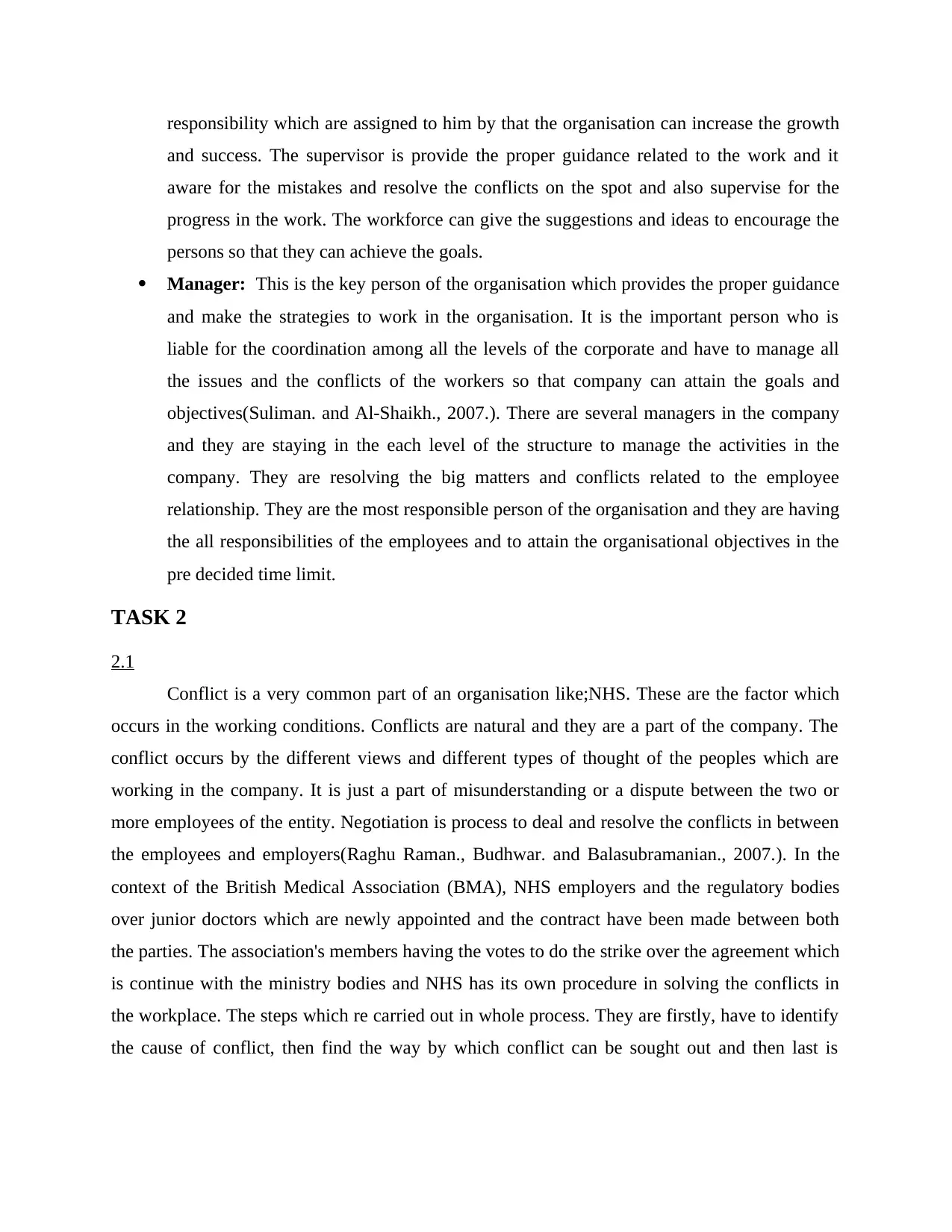
responsibility which are assigned to him by that the organisation can increase the growth
and success. The supervisor is provide the proper guidance related to the work and it
aware for the mistakes and resolve the conflicts on the spot and also supervise for the
progress in the work. The workforce can give the suggestions and ideas to encourage the
persons so that they can achieve the goals.
Manager: This is the key person of the organisation which provides the proper guidance
and make the strategies to work in the organisation. It is the important person who is
liable for the coordination among all the levels of the corporate and have to manage all
the issues and the conflicts of the workers so that company can attain the goals and
objectives(Suliman. and Al-Shaikh., 2007.). There are several managers in the company
and they are staying in the each level of the structure to manage the activities in the
company. They are resolving the big matters and conflicts related to the employee
relationship. They are the most responsible person of the organisation and they are having
the all responsibilities of the employees and to attain the organisational objectives in the
pre decided time limit.
TASK 2
2.1
Conflict is a very common part of an organisation like;NHS. These are the factor which
occurs in the working conditions. Conflicts are natural and they are a part of the company. The
conflict occurs by the different views and different types of thought of the peoples which are
working in the company. It is just a part of misunderstanding or a dispute between the two or
more employees of the entity. Negotiation is process to deal and resolve the conflicts in between
the employees and employers(Raghu Raman., Budhwar. and Balasubramanian., 2007.). In the
context of the British Medical Association (BMA), NHS employers and the regulatory bodies
over junior doctors which are newly appointed and the contract have been made between both
the parties. The association's members having the votes to do the strike over the agreement which
is continue with the ministry bodies and NHS has its own procedure in solving the conflicts in
the workplace. The steps which re carried out in whole process. They are firstly, have to identify
the cause of conflict, then find the way by which conflict can be sought out and then last is
and success. The supervisor is provide the proper guidance related to the work and it
aware for the mistakes and resolve the conflicts on the spot and also supervise for the
progress in the work. The workforce can give the suggestions and ideas to encourage the
persons so that they can achieve the goals.
Manager: This is the key person of the organisation which provides the proper guidance
and make the strategies to work in the organisation. It is the important person who is
liable for the coordination among all the levels of the corporate and have to manage all
the issues and the conflicts of the workers so that company can attain the goals and
objectives(Suliman. and Al-Shaikh., 2007.). There are several managers in the company
and they are staying in the each level of the structure to manage the activities in the
company. They are resolving the big matters and conflicts related to the employee
relationship. They are the most responsible person of the organisation and they are having
the all responsibilities of the employees and to attain the organisational objectives in the
pre decided time limit.
TASK 2
2.1
Conflict is a very common part of an organisation like;NHS. These are the factor which
occurs in the working conditions. Conflicts are natural and they are a part of the company. The
conflict occurs by the different views and different types of thought of the peoples which are
working in the company. It is just a part of misunderstanding or a dispute between the two or
more employees of the entity. Negotiation is process to deal and resolve the conflicts in between
the employees and employers(Raghu Raman., Budhwar. and Balasubramanian., 2007.). In the
context of the British Medical Association (BMA), NHS employers and the regulatory bodies
over junior doctors which are newly appointed and the contract have been made between both
the parties. The association's members having the votes to do the strike over the agreement which
is continue with the ministry bodies and NHS has its own procedure in solving the conflicts in
the workplace. The steps which re carried out in whole process. They are firstly, have to identify
the cause of conflict, then find the way by which conflict can be sought out and then last is
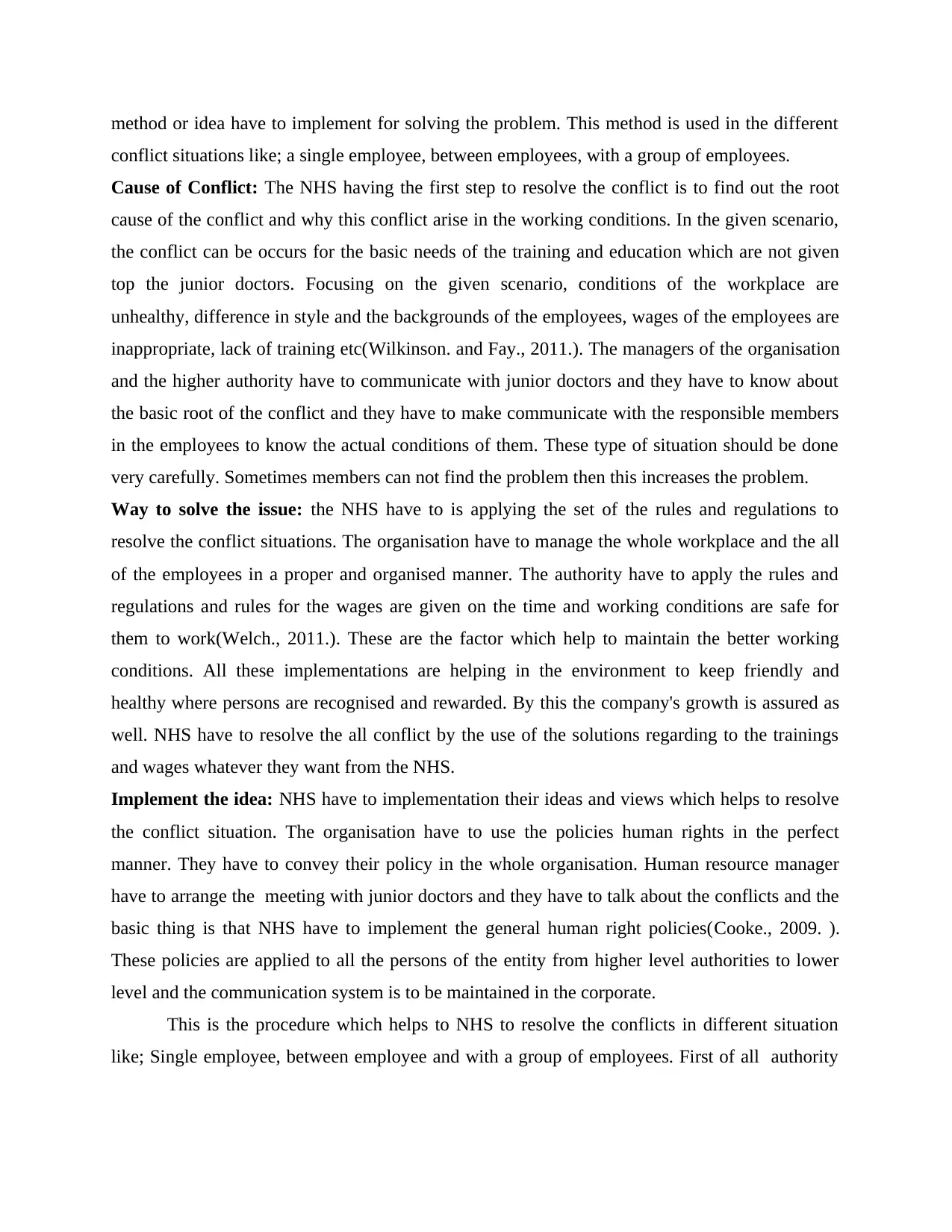
method or idea have to implement for solving the problem. This method is used in the different
conflict situations like; a single employee, between employees, with a group of employees.
Cause of Conflict: The NHS having the first step to resolve the conflict is to find out the root
cause of the conflict and why this conflict arise in the working conditions. In the given scenario,
the conflict can be occurs for the basic needs of the training and education which are not given
top the junior doctors. Focusing on the given scenario, conditions of the workplace are
unhealthy, difference in style and the backgrounds of the employees, wages of the employees are
inappropriate, lack of training etc(Wilkinson. and Fay., 2011.). The managers of the organisation
and the higher authority have to communicate with junior doctors and they have to know about
the basic root of the conflict and they have to make communicate with the responsible members
in the employees to know the actual conditions of them. These type of situation should be done
very carefully. Sometimes members can not find the problem then this increases the problem.
Way to solve the issue: the NHS have to is applying the set of the rules and regulations to
resolve the conflict situations. The organisation have to manage the whole workplace and the all
of the employees in a proper and organised manner. The authority have to apply the rules and
regulations and rules for the wages are given on the time and working conditions are safe for
them to work(Welch., 2011.). These are the factor which help to maintain the better working
conditions. All these implementations are helping in the environment to keep friendly and
healthy where persons are recognised and rewarded. By this the company's growth is assured as
well. NHS have to resolve the all conflict by the use of the solutions regarding to the trainings
and wages whatever they want from the NHS.
Implement the idea: NHS have to implementation their ideas and views which helps to resolve
the conflict situation. The organisation have to use the policies human rights in the perfect
manner. They have to convey their policy in the whole organisation. Human resource manager
have to arrange the meeting with junior doctors and they have to talk about the conflicts and the
basic thing is that NHS have to implement the general human right policies(Cooke., 2009. ).
These policies are applied to all the persons of the entity from higher level authorities to lower
level and the communication system is to be maintained in the corporate.
This is the procedure which helps to NHS to resolve the conflicts in different situation
like; Single employee, between employee and with a group of employees. First of all authority
conflict situations like; a single employee, between employees, with a group of employees.
Cause of Conflict: The NHS having the first step to resolve the conflict is to find out the root
cause of the conflict and why this conflict arise in the working conditions. In the given scenario,
the conflict can be occurs for the basic needs of the training and education which are not given
top the junior doctors. Focusing on the given scenario, conditions of the workplace are
unhealthy, difference in style and the backgrounds of the employees, wages of the employees are
inappropriate, lack of training etc(Wilkinson. and Fay., 2011.). The managers of the organisation
and the higher authority have to communicate with junior doctors and they have to know about
the basic root of the conflict and they have to make communicate with the responsible members
in the employees to know the actual conditions of them. These type of situation should be done
very carefully. Sometimes members can not find the problem then this increases the problem.
Way to solve the issue: the NHS have to is applying the set of the rules and regulations to
resolve the conflict situations. The organisation have to manage the whole workplace and the all
of the employees in a proper and organised manner. The authority have to apply the rules and
regulations and rules for the wages are given on the time and working conditions are safe for
them to work(Welch., 2011.). These are the factor which help to maintain the better working
conditions. All these implementations are helping in the environment to keep friendly and
healthy where persons are recognised and rewarded. By this the company's growth is assured as
well. NHS have to resolve the all conflict by the use of the solutions regarding to the trainings
and wages whatever they want from the NHS.
Implement the idea: NHS have to implementation their ideas and views which helps to resolve
the conflict situation. The organisation have to use the policies human rights in the perfect
manner. They have to convey their policy in the whole organisation. Human resource manager
have to arrange the meeting with junior doctors and they have to talk about the conflicts and the
basic thing is that NHS have to implement the general human right policies(Cooke., 2009. ).
These policies are applied to all the persons of the entity from higher level authorities to lower
level and the communication system is to be maintained in the corporate.
This is the procedure which helps to NHS to resolve the conflicts in different situation
like; Single employee, between employee and with a group of employees. First of all authority
Paraphrase This Document
Need a fresh take? Get an instant paraphrase of this document with our AI Paraphraser
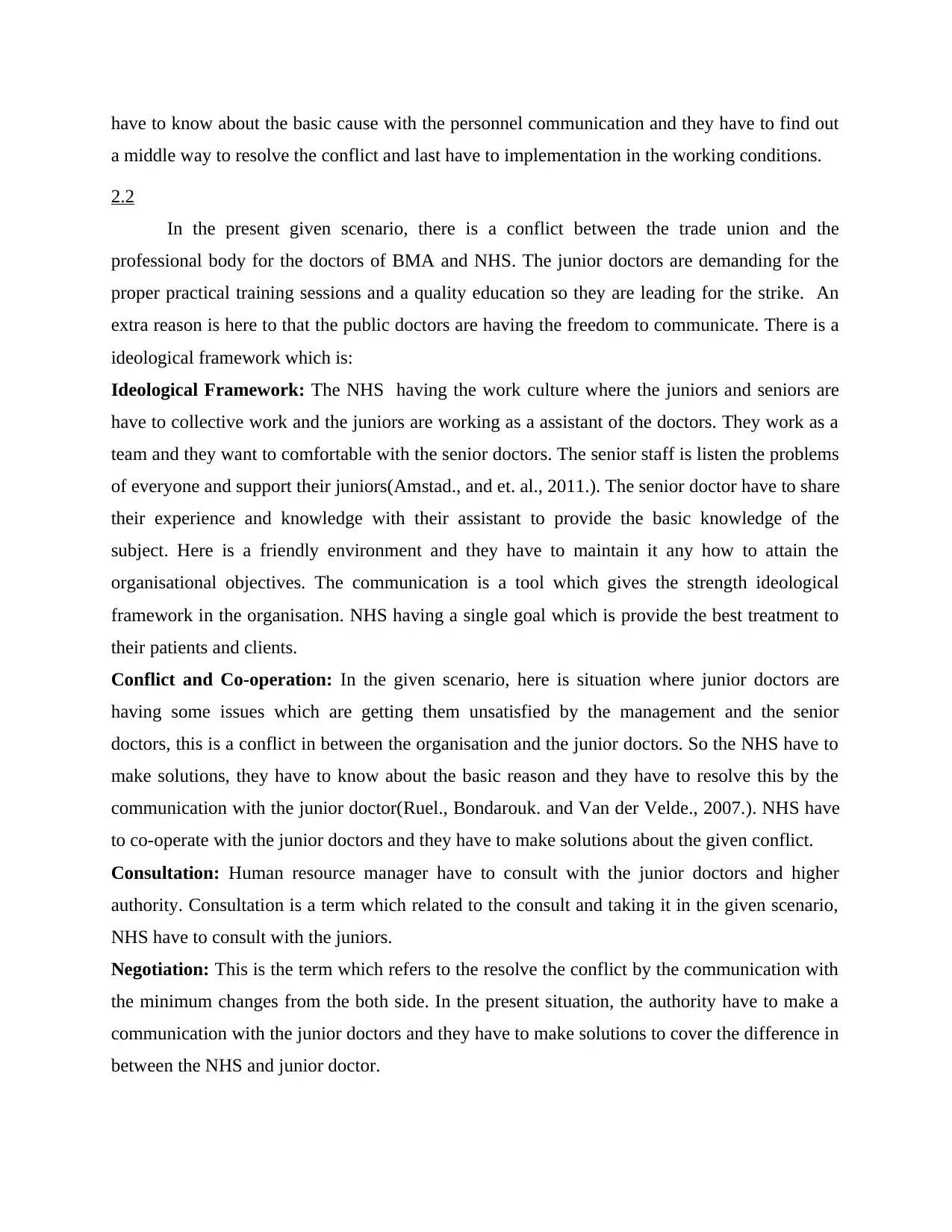
have to know about the basic cause with the personnel communication and they have to find out
a middle way to resolve the conflict and last have to implementation in the working conditions.
2.2
In the present given scenario, there is a conflict between the trade union and the
professional body for the doctors of BMA and NHS. The junior doctors are demanding for the
proper practical training sessions and a quality education so they are leading for the strike. An
extra reason is here to that the public doctors are having the freedom to communicate. There is a
ideological framework which is:
Ideological Framework: The NHS having the work culture where the juniors and seniors are
have to collective work and the juniors are working as a assistant of the doctors. They work as a
team and they want to comfortable with the senior doctors. The senior staff is listen the problems
of everyone and support their juniors(Amstad., and et. al., 2011.). The senior doctor have to share
their experience and knowledge with their assistant to provide the basic knowledge of the
subject. Here is a friendly environment and they have to maintain it any how to attain the
organisational objectives. The communication is a tool which gives the strength ideological
framework in the organisation. NHS having a single goal which is provide the best treatment to
their patients and clients.
Conflict and Co-operation: In the given scenario, here is situation where junior doctors are
having some issues which are getting them unsatisfied by the management and the senior
doctors, this is a conflict in between the organisation and the junior doctors. So the NHS have to
make solutions, they have to know about the basic reason and they have to resolve this by the
communication with the junior doctor(Ruel., Bondarouk. and Van der Velde., 2007.). NHS have
to co-operate with the junior doctors and they have to make solutions about the given conflict.
Consultation: Human resource manager have to consult with the junior doctors and higher
authority. Consultation is a term which related to the consult and taking it in the given scenario,
NHS have to consult with the juniors.
Negotiation: This is the term which refers to the resolve the conflict by the communication with
the minimum changes from the both side. In the present situation, the authority have to make a
communication with the junior doctors and they have to make solutions to cover the difference in
between the NHS and junior doctor.
a middle way to resolve the conflict and last have to implementation in the working conditions.
2.2
In the present given scenario, there is a conflict between the trade union and the
professional body for the doctors of BMA and NHS. The junior doctors are demanding for the
proper practical training sessions and a quality education so they are leading for the strike. An
extra reason is here to that the public doctors are having the freedom to communicate. There is a
ideological framework which is:
Ideological Framework: The NHS having the work culture where the juniors and seniors are
have to collective work and the juniors are working as a assistant of the doctors. They work as a
team and they want to comfortable with the senior doctors. The senior staff is listen the problems
of everyone and support their juniors(Amstad., and et. al., 2011.). The senior doctor have to share
their experience and knowledge with their assistant to provide the basic knowledge of the
subject. Here is a friendly environment and they have to maintain it any how to attain the
organisational objectives. The communication is a tool which gives the strength ideological
framework in the organisation. NHS having a single goal which is provide the best treatment to
their patients and clients.
Conflict and Co-operation: In the given scenario, here is situation where junior doctors are
having some issues which are getting them unsatisfied by the management and the senior
doctors, this is a conflict in between the organisation and the junior doctors. So the NHS have to
make solutions, they have to know about the basic reason and they have to resolve this by the
communication with the junior doctor(Ruel., Bondarouk. and Van der Velde., 2007.). NHS have
to co-operate with the junior doctors and they have to make solutions about the given conflict.
Consultation: Human resource manager have to consult with the junior doctors and higher
authority. Consultation is a term which related to the consult and taking it in the given scenario,
NHS have to consult with the juniors.
Negotiation: This is the term which refers to the resolve the conflict by the communication with
the minimum changes from the both side. In the present situation, the authority have to make a
communication with the junior doctors and they have to make solutions to cover the difference in
between the NHS and junior doctor.
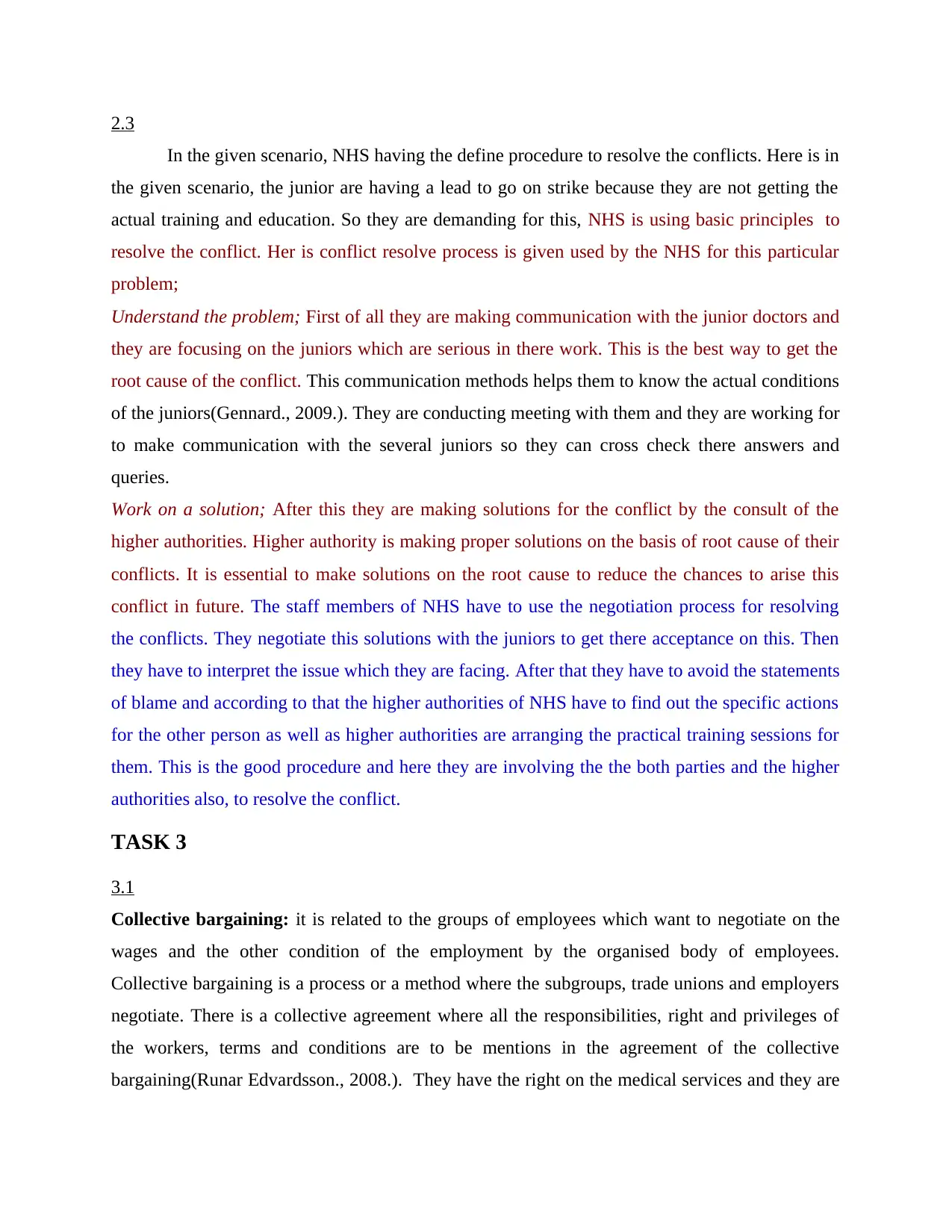
2.3
In the given scenario, NHS having the define procedure to resolve the conflicts. Here is in
the given scenario, the junior are having a lead to go on strike because they are not getting the
actual training and education. So they are demanding for this, NHS is using basic principles to
resolve the conflict. Her is conflict resolve process is given used by the NHS for this particular
problem;
Understand the problem; First of all they are making communication with the junior doctors and
they are focusing on the juniors which are serious in there work. This is the best way to get the
root cause of the conflict. This communication methods helps them to know the actual conditions
of the juniors(Gennard., 2009.). They are conducting meeting with them and they are working for
to make communication with the several juniors so they can cross check there answers and
queries.
Work on a solution; After this they are making solutions for the conflict by the consult of the
higher authorities. Higher authority is making proper solutions on the basis of root cause of their
conflicts. It is essential to make solutions on the root cause to reduce the chances to arise this
conflict in future. The staff members of NHS have to use the negotiation process for resolving
the conflicts. They negotiate this solutions with the juniors to get there acceptance on this. Then
they have to interpret the issue which they are facing. After that they have to avoid the statements
of blame and according to that the higher authorities of NHS have to find out the specific actions
for the other person as well as higher authorities are arranging the practical training sessions for
them. This is the good procedure and here they are involving the the both parties and the higher
authorities also, to resolve the conflict.
TASK 3
3.1
Collective bargaining: it is related to the groups of employees which want to negotiate on the
wages and the other condition of the employment by the organised body of employees.
Collective bargaining is a process or a method where the subgroups, trade unions and employers
negotiate. There is a collective agreement where all the responsibilities, right and privileges of
the workers, terms and conditions are to be mentions in the agreement of the collective
bargaining(Runar Edvardsson., 2008.). They have the right on the medical services and they are
In the given scenario, NHS having the define procedure to resolve the conflicts. Here is in
the given scenario, the junior are having a lead to go on strike because they are not getting the
actual training and education. So they are demanding for this, NHS is using basic principles to
resolve the conflict. Her is conflict resolve process is given used by the NHS for this particular
problem;
Understand the problem; First of all they are making communication with the junior doctors and
they are focusing on the juniors which are serious in there work. This is the best way to get the
root cause of the conflict. This communication methods helps them to know the actual conditions
of the juniors(Gennard., 2009.). They are conducting meeting with them and they are working for
to make communication with the several juniors so they can cross check there answers and
queries.
Work on a solution; After this they are making solutions for the conflict by the consult of the
higher authorities. Higher authority is making proper solutions on the basis of root cause of their
conflicts. It is essential to make solutions on the root cause to reduce the chances to arise this
conflict in future. The staff members of NHS have to use the negotiation process for resolving
the conflicts. They negotiate this solutions with the juniors to get there acceptance on this. Then
they have to interpret the issue which they are facing. After that they have to avoid the statements
of blame and according to that the higher authorities of NHS have to find out the specific actions
for the other person as well as higher authorities are arranging the practical training sessions for
them. This is the good procedure and here they are involving the the both parties and the higher
authorities also, to resolve the conflict.
TASK 3
3.1
Collective bargaining: it is related to the groups of employees which want to negotiate on the
wages and the other condition of the employment by the organised body of employees.
Collective bargaining is a process or a method where the subgroups, trade unions and employers
negotiate. There is a collective agreement where all the responsibilities, right and privileges of
the workers, terms and conditions are to be mentions in the agreement of the collective
bargaining(Runar Edvardsson., 2008.). They have the right on the medical services and they are
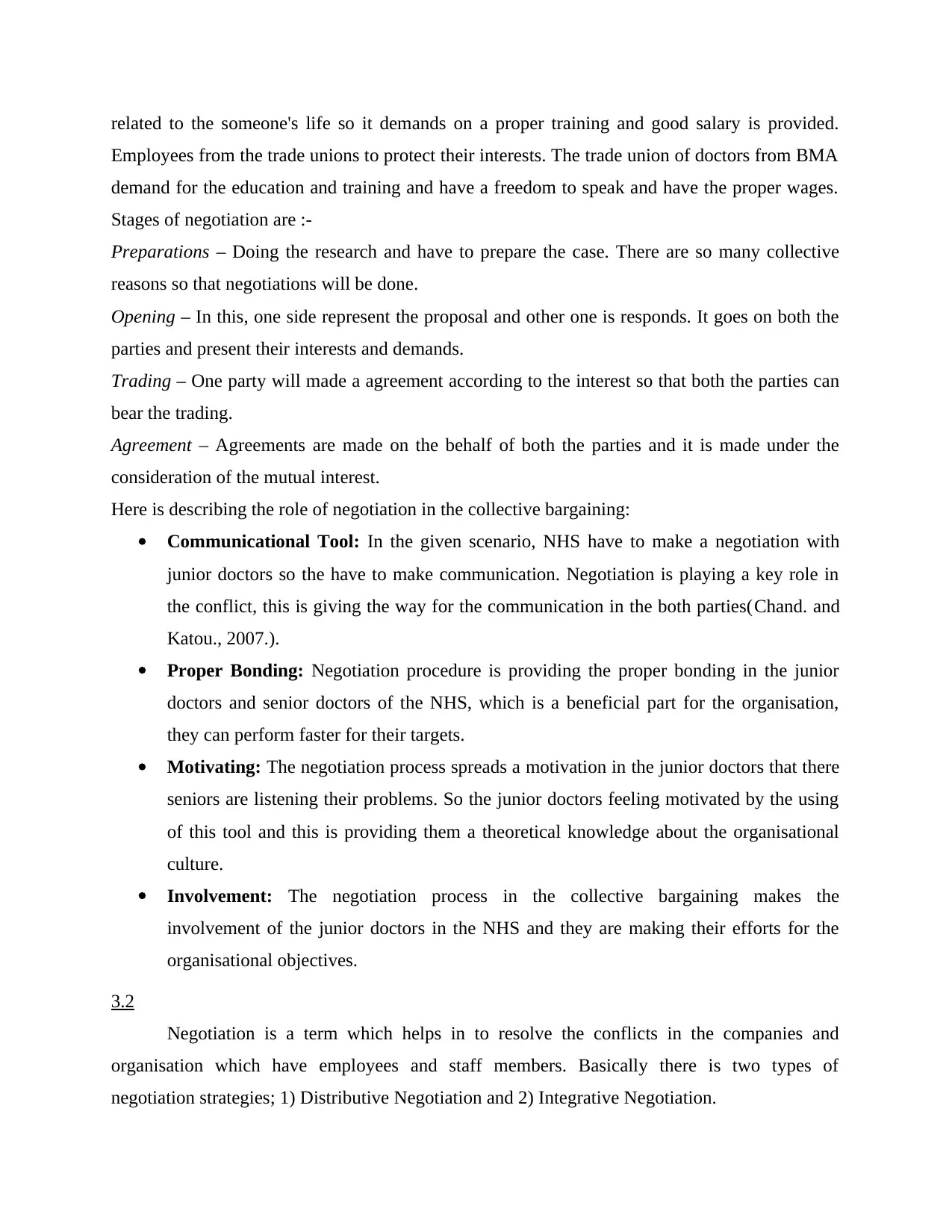
related to the someone's life so it demands on a proper training and good salary is provided.
Employees from the trade unions to protect their interests. The trade union of doctors from BMA
demand for the education and training and have a freedom to speak and have the proper wages.
Stages of negotiation are :-
Preparations – Doing the research and have to prepare the case. There are so many collective
reasons so that negotiations will be done.
Opening – In this, one side represent the proposal and other one is responds. It goes on both the
parties and present their interests and demands.
Trading – One party will made a agreement according to the interest so that both the parties can
bear the trading.
Agreement – Agreements are made on the behalf of both the parties and it is made under the
consideration of the mutual interest.
Here is describing the role of negotiation in the collective bargaining:
Communicational Tool: In the given scenario, NHS have to make a negotiation with
junior doctors so the have to make communication. Negotiation is playing a key role in
the conflict, this is giving the way for the communication in the both parties(Chand. and
Katou., 2007.).
Proper Bonding: Negotiation procedure is providing the proper bonding in the junior
doctors and senior doctors of the NHS, which is a beneficial part for the organisation,
they can perform faster for their targets.
Motivating: The negotiation process spreads a motivation in the junior doctors that there
seniors are listening their problems. So the junior doctors feeling motivated by the using
of this tool and this is providing them a theoretical knowledge about the organisational
culture.
Involvement: The negotiation process in the collective bargaining makes the
involvement of the junior doctors in the NHS and they are making their efforts for the
organisational objectives.
3.2
Negotiation is a term which helps in to resolve the conflicts in the companies and
organisation which have employees and staff members. Basically there is two types of
negotiation strategies; 1) Distributive Negotiation and 2) Integrative Negotiation.
Employees from the trade unions to protect their interests. The trade union of doctors from BMA
demand for the education and training and have a freedom to speak and have the proper wages.
Stages of negotiation are :-
Preparations – Doing the research and have to prepare the case. There are so many collective
reasons so that negotiations will be done.
Opening – In this, one side represent the proposal and other one is responds. It goes on both the
parties and present their interests and demands.
Trading – One party will made a agreement according to the interest so that both the parties can
bear the trading.
Agreement – Agreements are made on the behalf of both the parties and it is made under the
consideration of the mutual interest.
Here is describing the role of negotiation in the collective bargaining:
Communicational Tool: In the given scenario, NHS have to make a negotiation with
junior doctors so the have to make communication. Negotiation is playing a key role in
the conflict, this is giving the way for the communication in the both parties(Chand. and
Katou., 2007.).
Proper Bonding: Negotiation procedure is providing the proper bonding in the junior
doctors and senior doctors of the NHS, which is a beneficial part for the organisation,
they can perform faster for their targets.
Motivating: The negotiation process spreads a motivation in the junior doctors that there
seniors are listening their problems. So the junior doctors feeling motivated by the using
of this tool and this is providing them a theoretical knowledge about the organisational
culture.
Involvement: The negotiation process in the collective bargaining makes the
involvement of the junior doctors in the NHS and they are making their efforts for the
organisational objectives.
3.2
Negotiation is a term which helps in to resolve the conflicts in the companies and
organisation which have employees and staff members. Basically there is two types of
negotiation strategies; 1) Distributive Negotiation and 2) Integrative Negotiation.
Secure Best Marks with AI Grader
Need help grading? Try our AI Grader for instant feedback on your assignments.
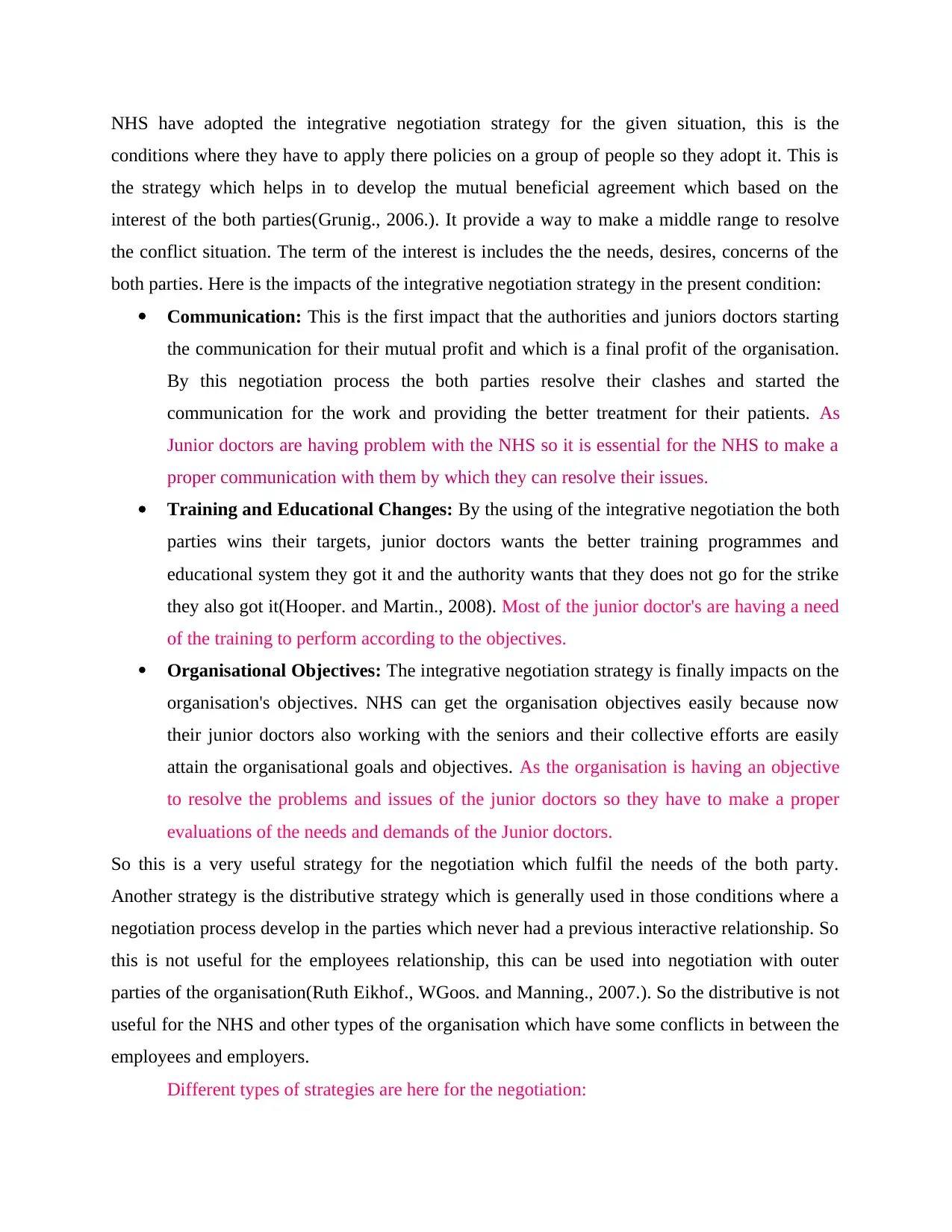
NHS have adopted the integrative negotiation strategy for the given situation, this is the
conditions where they have to apply there policies on a group of people so they adopt it. This is
the strategy which helps in to develop the mutual beneficial agreement which based on the
interest of the both parties(Grunig., 2006.). It provide a way to make a middle range to resolve
the conflict situation. The term of the interest is includes the the needs, desires, concerns of the
both parties. Here is the impacts of the integrative negotiation strategy in the present condition:
Communication: This is the first impact that the authorities and juniors doctors starting
the communication for their mutual profit and which is a final profit of the organisation.
By this negotiation process the both parties resolve their clashes and started the
communication for the work and providing the better treatment for their patients. As
Junior doctors are having problem with the NHS so it is essential for the NHS to make a
proper communication with them by which they can resolve their issues.
Training and Educational Changes: By the using of the integrative negotiation the both
parties wins their targets, junior doctors wants the better training programmes and
educational system they got it and the authority wants that they does not go for the strike
they also got it(Hooper. and Martin., 2008). Most of the junior doctor's are having a need
of the training to perform according to the objectives.
Organisational Objectives: The integrative negotiation strategy is finally impacts on the
organisation's objectives. NHS can get the organisation objectives easily because now
their junior doctors also working with the seniors and their collective efforts are easily
attain the organisational goals and objectives. As the organisation is having an objective
to resolve the problems and issues of the junior doctors so they have to make a proper
evaluations of the needs and demands of the Junior doctors.
So this is a very useful strategy for the negotiation which fulfil the needs of the both party.
Another strategy is the distributive strategy which is generally used in those conditions where a
negotiation process develop in the parties which never had a previous interactive relationship. So
this is not useful for the employees relationship, this can be used into negotiation with outer
parties of the organisation(Ruth Eikhof., WGoos. and Manning., 2007.). So the distributive is not
useful for the NHS and other types of the organisation which have some conflicts in between the
employees and employers.
Different types of strategies are here for the negotiation:
conditions where they have to apply there policies on a group of people so they adopt it. This is
the strategy which helps in to develop the mutual beneficial agreement which based on the
interest of the both parties(Grunig., 2006.). It provide a way to make a middle range to resolve
the conflict situation. The term of the interest is includes the the needs, desires, concerns of the
both parties. Here is the impacts of the integrative negotiation strategy in the present condition:
Communication: This is the first impact that the authorities and juniors doctors starting
the communication for their mutual profit and which is a final profit of the organisation.
By this negotiation process the both parties resolve their clashes and started the
communication for the work and providing the better treatment for their patients. As
Junior doctors are having problem with the NHS so it is essential for the NHS to make a
proper communication with them by which they can resolve their issues.
Training and Educational Changes: By the using of the integrative negotiation the both
parties wins their targets, junior doctors wants the better training programmes and
educational system they got it and the authority wants that they does not go for the strike
they also got it(Hooper. and Martin., 2008). Most of the junior doctor's are having a need
of the training to perform according to the objectives.
Organisational Objectives: The integrative negotiation strategy is finally impacts on the
organisation's objectives. NHS can get the organisation objectives easily because now
their junior doctors also working with the seniors and their collective efforts are easily
attain the organisational goals and objectives. As the organisation is having an objective
to resolve the problems and issues of the junior doctors so they have to make a proper
evaluations of the needs and demands of the Junior doctors.
So this is a very useful strategy for the negotiation which fulfil the needs of the both party.
Another strategy is the distributive strategy which is generally used in those conditions where a
negotiation process develop in the parties which never had a previous interactive relationship. So
this is not useful for the employees relationship, this can be used into negotiation with outer
parties of the organisation(Ruth Eikhof., WGoos. and Manning., 2007.). So the distributive is not
useful for the NHS and other types of the organisation which have some conflicts in between the
employees and employers.
Different types of strategies are here for the negotiation:
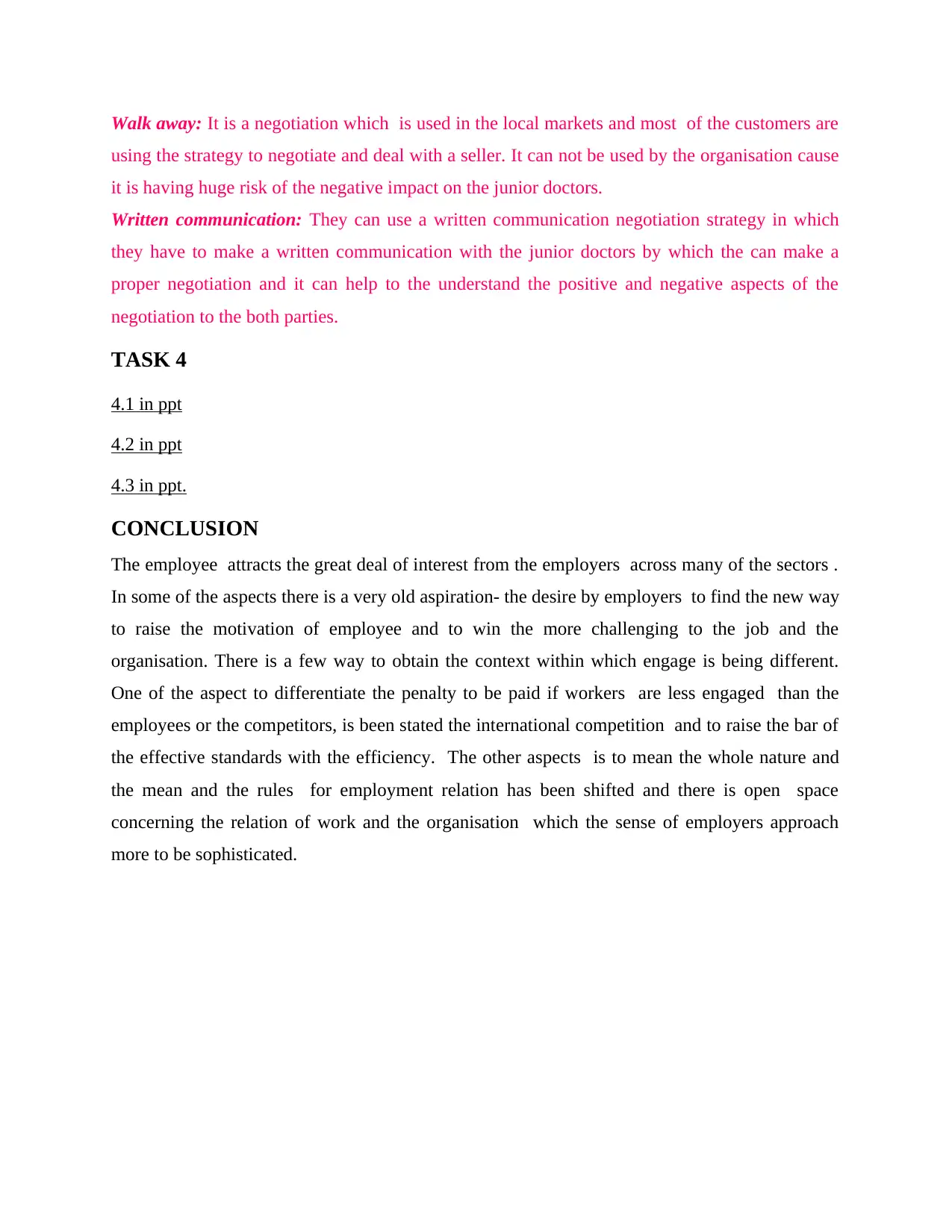
Walk away: It is a negotiation which is used in the local markets and most of the customers are
using the strategy to negotiate and deal with a seller. It can not be used by the organisation cause
it is having huge risk of the negative impact on the junior doctors.
Written communication: They can use a written communication negotiation strategy in which
they have to make a written communication with the junior doctors by which the can make a
proper negotiation and it can help to the understand the positive and negative aspects of the
negotiation to the both parties.
TASK 4
4.1 in ppt
4.2 in ppt
4.3 in ppt.
CONCLUSION
The employee attracts the great deal of interest from the employers across many of the sectors .
In some of the aspects there is a very old aspiration- the desire by employers to find the new way
to raise the motivation of employee and to win the more challenging to the job and the
organisation. There is a few way to obtain the context within which engage is being different.
One of the aspect to differentiate the penalty to be paid if workers are less engaged than the
employees or the competitors, is been stated the international competition and to raise the bar of
the effective standards with the efficiency. The other aspects is to mean the whole nature and
the mean and the rules for employment relation has been shifted and there is open space
concerning the relation of work and the organisation which the sense of employers approach
more to be sophisticated.
using the strategy to negotiate and deal with a seller. It can not be used by the organisation cause
it is having huge risk of the negative impact on the junior doctors.
Written communication: They can use a written communication negotiation strategy in which
they have to make a written communication with the junior doctors by which the can make a
proper negotiation and it can help to the understand the positive and negative aspects of the
negotiation to the both parties.
TASK 4
4.1 in ppt
4.2 in ppt
4.3 in ppt.
CONCLUSION
The employee attracts the great deal of interest from the employers across many of the sectors .
In some of the aspects there is a very old aspiration- the desire by employers to find the new way
to raise the motivation of employee and to win the more challenging to the job and the
organisation. There is a few way to obtain the context within which engage is being different.
One of the aspect to differentiate the penalty to be paid if workers are less engaged than the
employees or the competitors, is been stated the international competition and to raise the bar of
the effective standards with the efficiency. The other aspects is to mean the whole nature and
the mean and the rules for employment relation has been shifted and there is open space
concerning the relation of work and the organisation which the sense of employers approach
more to be sophisticated.
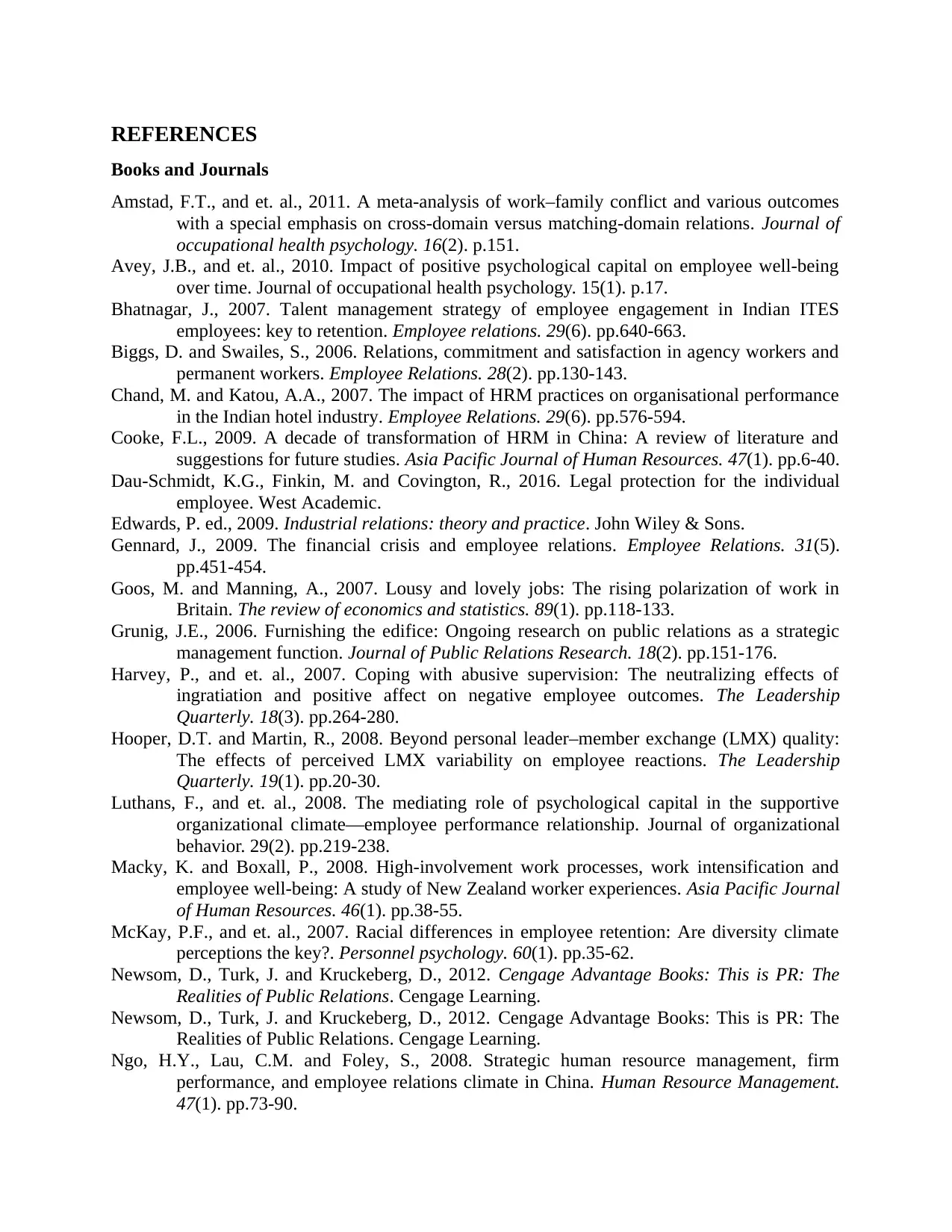
REFERENCES
Books and Journals
Amstad, F.T., and et. al., 2011. A meta-analysis of work–family conflict and various outcomes
with a special emphasis on cross-domain versus matching-domain relations. Journal of
occupational health psychology. 16(2). p.151.
Avey, J.B., and et. al., 2010. Impact of positive psychological capital on employee well-being
over time. Journal of occupational health psychology. 15(1). p.17.
Bhatnagar, J., 2007. Talent management strategy of employee engagement in Indian ITES
employees: key to retention. Employee relations. 29(6). pp.640-663.
Biggs, D. and Swailes, S., 2006. Relations, commitment and satisfaction in agency workers and
permanent workers. Employee Relations. 28(2). pp.130-143.
Chand, M. and Katou, A.A., 2007. The impact of HRM practices on organisational performance
in the Indian hotel industry. Employee Relations. 29(6). pp.576-594.
Cooke, F.L., 2009. A decade of transformation of HRM in China: A review of literature and
suggestions for future studies. Asia Pacific Journal of Human Resources. 47(1). pp.6-40.
Dau-Schmidt, K.G., Finkin, M. and Covington, R., 2016. Legal protection for the individual
employee. West Academic.
Edwards, P. ed., 2009. Industrial relations: theory and practice. John Wiley & Sons.
Gennard, J., 2009. The financial crisis and employee relations. Employee Relations. 31(5).
pp.451-454.
Goos, M. and Manning, A., 2007. Lousy and lovely jobs: The rising polarization of work in
Britain. The review of economics and statistics. 89(1). pp.118-133.
Grunig, J.E., 2006. Furnishing the edifice: Ongoing research on public relations as a strategic
management function. Journal of Public Relations Research. 18(2). pp.151-176.
Harvey, P., and et. al., 2007. Coping with abusive supervision: The neutralizing effects of
ingratiation and positive affect on negative employee outcomes. The Leadership
Quarterly. 18(3). pp.264-280.
Hooper, D.T. and Martin, R., 2008. Beyond personal leader–member exchange (LMX) quality:
The effects of perceived LMX variability on employee reactions. The Leadership
Quarterly. 19(1). pp.20-30.
Luthans, F., and et. al., 2008. The mediating role of psychological capital in the supportive
organizational climate—employee performance relationship. Journal of organizational
behavior. 29(2). pp.219-238.
Macky, K. and Boxall, P., 2008. High-involvement work processes, work intensification and
employee well-being: A study of New Zealand worker experiences. Asia Pacific Journal
of Human Resources. 46(1). pp.38-55.
McKay, P.F., and et. al., 2007. Racial differences in employee retention: Are diversity climate
perceptions the key?. Personnel psychology. 60(1). pp.35-62.
Newsom, D., Turk, J. and Kruckeberg, D., 2012. Cengage Advantage Books: This is PR: The
Realities of Public Relations. Cengage Learning.
Newsom, D., Turk, J. and Kruckeberg, D., 2012. Cengage Advantage Books: This is PR: The
Realities of Public Relations. Cengage Learning.
Ngo, H.Y., Lau, C.M. and Foley, S., 2008. Strategic human resource management, firm
performance, and employee relations climate in China. Human Resource Management.
47(1). pp.73-90.
Books and Journals
Amstad, F.T., and et. al., 2011. A meta-analysis of work–family conflict and various outcomes
with a special emphasis on cross-domain versus matching-domain relations. Journal of
occupational health psychology. 16(2). p.151.
Avey, J.B., and et. al., 2010. Impact of positive psychological capital on employee well-being
over time. Journal of occupational health psychology. 15(1). p.17.
Bhatnagar, J., 2007. Talent management strategy of employee engagement in Indian ITES
employees: key to retention. Employee relations. 29(6). pp.640-663.
Biggs, D. and Swailes, S., 2006. Relations, commitment and satisfaction in agency workers and
permanent workers. Employee Relations. 28(2). pp.130-143.
Chand, M. and Katou, A.A., 2007. The impact of HRM practices on organisational performance
in the Indian hotel industry. Employee Relations. 29(6). pp.576-594.
Cooke, F.L., 2009. A decade of transformation of HRM in China: A review of literature and
suggestions for future studies. Asia Pacific Journal of Human Resources. 47(1). pp.6-40.
Dau-Schmidt, K.G., Finkin, M. and Covington, R., 2016. Legal protection for the individual
employee. West Academic.
Edwards, P. ed., 2009. Industrial relations: theory and practice. John Wiley & Sons.
Gennard, J., 2009. The financial crisis and employee relations. Employee Relations. 31(5).
pp.451-454.
Goos, M. and Manning, A., 2007. Lousy and lovely jobs: The rising polarization of work in
Britain. The review of economics and statistics. 89(1). pp.118-133.
Grunig, J.E., 2006. Furnishing the edifice: Ongoing research on public relations as a strategic
management function. Journal of Public Relations Research. 18(2). pp.151-176.
Harvey, P., and et. al., 2007. Coping with abusive supervision: The neutralizing effects of
ingratiation and positive affect on negative employee outcomes. The Leadership
Quarterly. 18(3). pp.264-280.
Hooper, D.T. and Martin, R., 2008. Beyond personal leader–member exchange (LMX) quality:
The effects of perceived LMX variability on employee reactions. The Leadership
Quarterly. 19(1). pp.20-30.
Luthans, F., and et. al., 2008. The mediating role of psychological capital in the supportive
organizational climate—employee performance relationship. Journal of organizational
behavior. 29(2). pp.219-238.
Macky, K. and Boxall, P., 2008. High-involvement work processes, work intensification and
employee well-being: A study of New Zealand worker experiences. Asia Pacific Journal
of Human Resources. 46(1). pp.38-55.
McKay, P.F., and et. al., 2007. Racial differences in employee retention: Are diversity climate
perceptions the key?. Personnel psychology. 60(1). pp.35-62.
Newsom, D., Turk, J. and Kruckeberg, D., 2012. Cengage Advantage Books: This is PR: The
Realities of Public Relations. Cengage Learning.
Newsom, D., Turk, J. and Kruckeberg, D., 2012. Cengage Advantage Books: This is PR: The
Realities of Public Relations. Cengage Learning.
Ngo, H.Y., Lau, C.M. and Foley, S., 2008. Strategic human resource management, firm
performance, and employee relations climate in China. Human Resource Management.
47(1). pp.73-90.
Paraphrase This Document
Need a fresh take? Get an instant paraphrase of this document with our AI Paraphraser
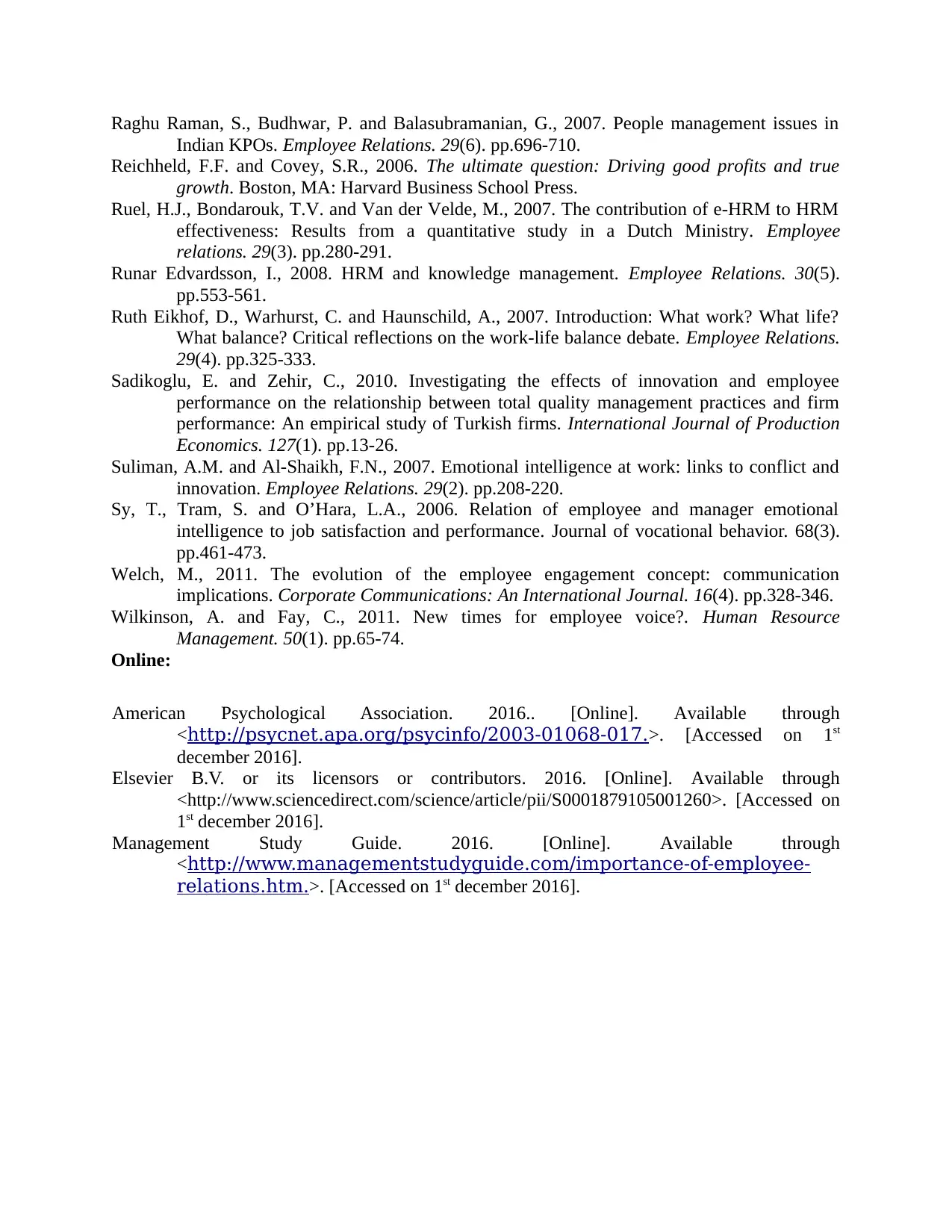
Raghu Raman, S., Budhwar, P. and Balasubramanian, G., 2007. People management issues in
Indian KPOs. Employee Relations. 29(6). pp.696-710.
Reichheld, F.F. and Covey, S.R., 2006. The ultimate question: Driving good profits and true
growth. Boston, MA: Harvard Business School Press.
Ruel, H.J., Bondarouk, T.V. and Van der Velde, M., 2007. The contribution of e-HRM to HRM
effectiveness: Results from a quantitative study in a Dutch Ministry. Employee
relations. 29(3). pp.280-291.
Runar Edvardsson, I., 2008. HRM and knowledge management. Employee Relations. 30(5).
pp.553-561.
Ruth Eikhof, D., Warhurst, C. and Haunschild, A., 2007. Introduction: What work? What life?
What balance? Critical reflections on the work-life balance debate. Employee Relations.
29(4). pp.325-333.
Sadikoglu, E. and Zehir, C., 2010. Investigating the effects of innovation and employee
performance on the relationship between total quality management practices and firm
performance: An empirical study of Turkish firms. International Journal of Production
Economics. 127(1). pp.13-26.
Suliman, A.M. and Al-Shaikh, F.N., 2007. Emotional intelligence at work: links to conflict and
innovation. Employee Relations. 29(2). pp.208-220.
Sy, T., Tram, S. and O’Hara, L.A., 2006. Relation of employee and manager emotional
intelligence to job satisfaction and performance. Journal of vocational behavior. 68(3).
pp.461-473.
Welch, M., 2011. The evolution of the employee engagement concept: communication
implications. Corporate Communications: An International Journal. 16(4). pp.328-346.
Wilkinson, A. and Fay, C., 2011. New times for employee voice?. Human Resource
Management. 50(1). pp.65-74.
Online:
American Psychological Association. 2016.. [Online]. Available through
<http://psycnet.apa.org/psycinfo/2003-01068-017.>. [Accessed on 1st
december 2016].
Elsevier B.V. or its licensors or contributors. 2016. [Online]. Available through
<http://www.sciencedirect.com/science/article/pii/S0001879105001260>. [Accessed on
1st december 2016].
Management Study Guide. 2016. [Online]. Available through
<http://www.managementstudyguide.com/importance-of-employee-
relations.htm.>. [Accessed on 1st december 2016].
Indian KPOs. Employee Relations. 29(6). pp.696-710.
Reichheld, F.F. and Covey, S.R., 2006. The ultimate question: Driving good profits and true
growth. Boston, MA: Harvard Business School Press.
Ruel, H.J., Bondarouk, T.V. and Van der Velde, M., 2007. The contribution of e-HRM to HRM
effectiveness: Results from a quantitative study in a Dutch Ministry. Employee
relations. 29(3). pp.280-291.
Runar Edvardsson, I., 2008. HRM and knowledge management. Employee Relations. 30(5).
pp.553-561.
Ruth Eikhof, D., Warhurst, C. and Haunschild, A., 2007. Introduction: What work? What life?
What balance? Critical reflections on the work-life balance debate. Employee Relations.
29(4). pp.325-333.
Sadikoglu, E. and Zehir, C., 2010. Investigating the effects of innovation and employee
performance on the relationship between total quality management practices and firm
performance: An empirical study of Turkish firms. International Journal of Production
Economics. 127(1). pp.13-26.
Suliman, A.M. and Al-Shaikh, F.N., 2007. Emotional intelligence at work: links to conflict and
innovation. Employee Relations. 29(2). pp.208-220.
Sy, T., Tram, S. and O’Hara, L.A., 2006. Relation of employee and manager emotional
intelligence to job satisfaction and performance. Journal of vocational behavior. 68(3).
pp.461-473.
Welch, M., 2011. The evolution of the employee engagement concept: communication
implications. Corporate Communications: An International Journal. 16(4). pp.328-346.
Wilkinson, A. and Fay, C., 2011. New times for employee voice?. Human Resource
Management. 50(1). pp.65-74.
Online:
American Psychological Association. 2016.. [Online]. Available through
<http://psycnet.apa.org/psycinfo/2003-01068-017.>. [Accessed on 1st
december 2016].
Elsevier B.V. or its licensors or contributors. 2016. [Online]. Available through
<http://www.sciencedirect.com/science/article/pii/S0001879105001260>. [Accessed on
1st december 2016].
Management Study Guide. 2016. [Online]. Available through
<http://www.managementstudyguide.com/importance-of-employee-
relations.htm.>. [Accessed on 1st december 2016].
1 out of 14
Related Documents
Your All-in-One AI-Powered Toolkit for Academic Success.
+13062052269
info@desklib.com
Available 24*7 on WhatsApp / Email
![[object Object]](/_next/static/media/star-bottom.7253800d.svg)
Unlock your academic potential
© 2024 | Zucol Services PVT LTD | All rights reserved.





